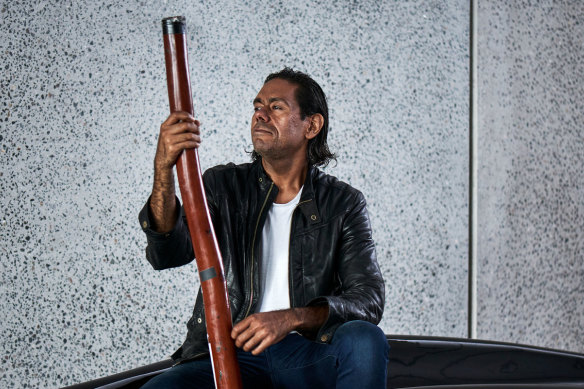Magician of the didgeridoo conjures Mount Isa sunset
By Peter McCallum
Ensemble Q and William Barton
Musica Viva
City Recital Hall, October 8
Reviewed by PETER McCALLUM
★★★
As stagehands prepared subtle amplification, William Barton, didgeridoo player, composer, elder of the Wannyi, Lardil and Kalkadunga people, and engaging speaker of gentle generosity, said he wanted the audience to feel the wind blowing through the spinifex and see the rugged beauty of the sunset at Mount Isa.
His Journey to the Edge of the Horizon for didgeridoo, wind quintet, cello and double bass placed the animated articulations and shifts of harmonic aura of the didgeridoo at the centre of the sound world like a pulsing heart.

William Barton’s Journey to the Edge of the Horizon places the didgeridoo at the centre of the sound world.Credit: Keith Saunders
Barton blended this with clapping stick beats and occasional vocalisations to highlight a melodic fragment. The outer parts were active, and in the middle section, the energy slackened with reflective vocalisations and a cadenza.
Of the range of heterogeneous sounds in Ensemble Q, who sat around in a half circle, Peter Luff’s horn combined most empathetically, its polished surface finding common grain with the textured didgeridoo tone. Phoebe Russell’s double bass added rapidly pointed pizzicato like a pebbly creek bed, and Trish Dean’s cello provided a flowing angular underlay.
Flute, oboe and clarinet (Alison Mitchel, Huw Jones and Paul Dean) added bird-like calls and whistling, sometimes growling, wind and David Mitchell’s bassoon partnered Barton’s singing with perfectly matched pitch. It was a coming together of sound worlds and cultures that met the yearning of many in the audience who gave it a standing ovation.
The other Australian work on the program was Paul Dean’s Concerto for cello and wind quintet, which paired the warm, rhapsodic sound of Trish Dean’s cello playing with the wind quintet’s bubbling pertness. At the start, bass clarinet, bassoon and horn set up a discreetly syncopated accompaniment to a cello melody of increasingly soaring range.
The cello developed this against changing patterns of light from the other instruments, rising to climactic intensity before returning to the opening idea. The second movement explored weaving overlapping lines, while the last was a homage to the irreverent brilliance of the group of early 20th-century French composers known as Les Six (though Dean’s sense of humour is not as dry as theirs).
Listening to the first movement of Brahms’s Sonata for cello and piano, arranged for cello, wind quintet and bass, the word that came to mind was, “why?” Brahms rejoiced in the noble resonance cello with piano, but the wind instruments had difficulty cutting back to allow the cello sound through.
The intermezzo-style second movement suited these instruments better. The concert began with a finely disciplined performance of Ligeti’s Six Bagatelles for Wind Quintet, ranging from rasping impertinence, finely shaded quietness, through to shades of the sardonic and the grotesque.